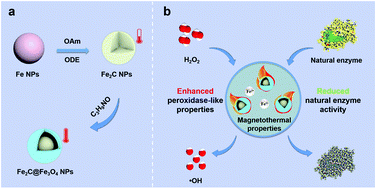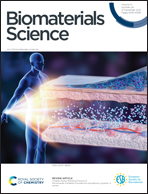An intrinsically thermogenic nanozyme for synergistic antibacterial therapy†
Abstract
Bacterial infections with a high mortality rate have become serious health issues for human beings. As natural enzymes play an important role in the survival and proliferation of bacteria, effective inhibition of bacterial natural enzyme activities is important for antimicrobial therapy. Herein, a novel enzymatic antibacterial strategy, of enhancing nanozyme activity but reducing bacterial natural enzyme activity, is developed based on yolk–shell Fe2C@Fe3O4-PEG thermogenic nanozymes with highly magnetothermal properties and thermal-enhanced peroxidase-like activities. When applying an alternating magnetic field, the special yolk–shell Fe2C@Fe3O4-PEG nanozymes show a better magnetothermal effect than Fe2C (yolk) and Fe3O4 (shell) due to the increased value of their magnetic energy product, and the peroxidase-like activity of the nanozymes is further improved. Meanwhile, remarkably restrained by the enhanced magnetothermal effect from the nanozymes, typical natural enzyme activities of bacteria are detected with an inhibition rate of nearly 80%. Both in vitro and in vivo experiments exhibit superior synergistic antibacterial efficacy. The antimicrobial mechanisms are explained as the reduction of natural enzyme activities and the disruption of cell walls and membranes induced by the self-magnetothermal effect of nanozymes along with the production of abundant ˙OH radicals derived from the thermal-enhanced peroxidase-like activity of nanozymes. Overall, this work focuses on an intrinsically thermogenic nanozyme, which provides a potential platform for future synergistic antibacterial application.



 Please wait while we load your content...
Please wait while we load your content...